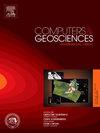Mineral prospectivity analysis is unstable to changes in pixel size
IF 4.4
2区 地球科学
Q1 COMPUTER SCIENCE, INTERDISCIPLINARY APPLICATIONS
引用次数: 0
Abstract
In mineral prospectivity mapping, the spatial coordinates of mineral deposits and other geological features are often recorded originally in vector form, and converted to a grid of cells (a raster of pixels) for analysis. Although the results of the analysis clearly depend on the choice of pixel size, it is widely believed that, if pixel size is progressively reduced, results should converge to a stable value. However, we show that this is not true. Using a database of gold deposits in the Murchison region of Western Australia, the Weights of Evidence (WofE) contrast statistic was calculated for raster conversions with pixel widths varying from 5 km to 100 m, using the vector-to-raster conversion algorithms common in mainstream GIS packages. In response to even the slightest changes in pixel width, the calculated value of fluctuated by 1.5 units, and the calculated probability of a deposit fluctuated by a factor of 4.5. As pixel size was progressively reduced, the results did not converge. We investigate this instability phenomenon experimentally and theoretically, and establish that it could be widespread. It could arise in any form of prospectivity analysis (including logistic regression, machine learning and deep learning) where the explanatory variables are discontinuous. We have confirmed that it also occurs with logistic regression. Instability is primarily associated with deposit points which lie close to a discontinuity such as a feature boundary, and could be characterised as a failure to respect “ground truth” at the deposit location. Accordingly, instability can persist even with very small pixel sizes (as small as 3 m in the Murchison example). We propose a new algorithm for vector-to-raster conversion which respects ground truth, and produces results which converge rapidly as pixel size decreases. In the Murchison example, this algorithm provides stable results for pixel widths of 500 m or less. Our theoretical results predict the maximum error as a function of pixel width, and allow the geologist to select an appropriate pixel size for the data available. Potential fields of application include species distribution modelling and geospatial risk analysis.
矿产找矿分析对像素大小的变化是不稳定的
在矿产勘探制图中,矿床和其他地质特征的空间坐标通常最初以矢量形式记录,然后转换为单元格(像素光栅)以供分析。虽然分析结果明显依赖于像素大小的选择,但人们普遍认为,如果像素大小逐渐减小,结果应该收敛到一个稳定的值。然而,我们证明这是不正确的。利用西澳大利亚Murchison地区的金矿数据库,使用主流GIS软件包中常见的矢量到栅格转换算法,计算了像素宽度从5公里到100米的栅格转换的证据权重(WofE)对比统计量C。即使像素宽度发生最微小的变化,C的计算值也会波动1.5个单位,而沉积的计算概率也会波动4.5倍。随着像素大小的逐渐减小,结果不收敛。我们从实验和理论上研究了这种不稳定现象,并确定它可能是普遍存在的。它可能出现在任何形式的前瞻性分析(包括逻辑回归、机器学习和深度学习)中,其中解释变量是不连续的。我们已经证实,逻辑回归也会出现这种情况。不稳定性主要与靠近不连续面(如地物边界)的沉积点有关,并且可以被描述为未能尊重沉积位置的“地面真相”。因此,即使是非常小的像素尺寸(Murchison的例子中小到3米),不稳定性也会持续存在。我们提出了一种新的矢量-栅格转换算法,该算法尊重地面真值,并产生了随着像素大小的减小而快速收敛的结果。在Murchison示例中,该算法在像素宽度为500 m或更小的情况下提供稳定的结果。我们的理论结果预测了最大误差作为像素宽度的函数,并允许地质学家为可用的数据选择适当的像素大小。潜在的应用领域包括物种分布建模和地理空间风险分析。
本文章由计算机程序翻译,如有差异,请以英文原文为准。
求助全文
约1分钟内获得全文
求助全文
来源期刊

Computers & Geosciences
地学-地球科学综合
CiteScore
9.30
自引率
6.80%
发文量
164
审稿时长
3.4 months
期刊介绍:
Computers & Geosciences publishes high impact, original research at the interface between Computer Sciences and Geosciences. Publications should apply modern computer science paradigms, whether computational or informatics-based, to address problems in the geosciences.
 求助内容:
求助内容: 应助结果提醒方式:
应助结果提醒方式:


